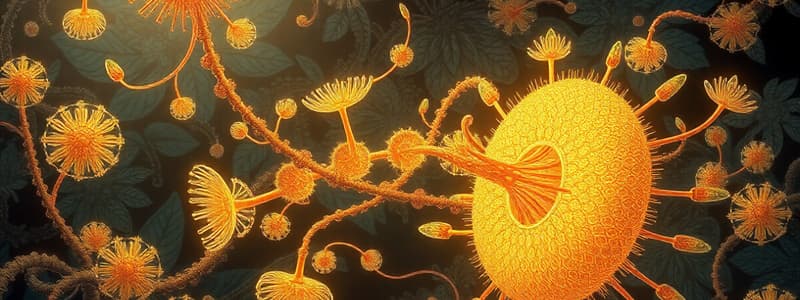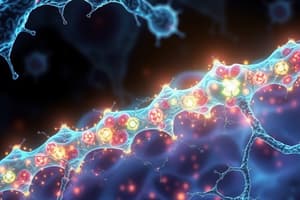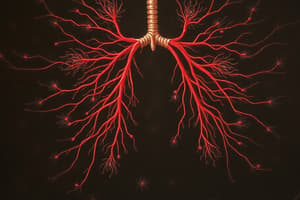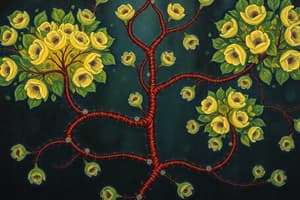Podcast
Questions and Answers
What is produced as a direct byproduct of anaerobic respiration in humans?
What is produced as a direct byproduct of anaerobic respiration in humans?
- Carbon Dioxide
- Oxygen
- Lactic Acid (correct)
- Alcohol
In which part of the cell does glycolysis occur?
In which part of the cell does glycolysis occur?
- Mitochondria
- Cytoplasm (correct)
- Nucleus
- Cell membrane
Which molecule is primarily used as an energy currency in cellular respiration?
Which molecule is primarily used as an energy currency in cellular respiration?
- FADH2
- Glucose
- NADH
- ATP (correct)
What happens to hydrogen ions during the Electron Transport Chain?
What happens to hydrogen ions during the Electron Transport Chain?
What type of respiration requires oxygen?
What type of respiration requires oxygen?
Which process occurs immediately after glycolysis?
Which process occurs immediately after glycolysis?
How many ATP molecules can be produced in aerobic respiration?
How many ATP molecules can be produced in aerobic respiration?
What is formed during the Kreb's Cycle as glucose is broken down?
What is formed during the Kreb's Cycle as glucose is broken down?
What is the primary role of the mitochondria in cellular respiration?
What is the primary role of the mitochondria in cellular respiration?
What happens to pyruvate after glycolysis in aerobic conditions?
What happens to pyruvate after glycolysis in aerobic conditions?
What is the primary end product of glycolysis?
What is the primary end product of glycolysis?
What role do mitochondria play in aerobic respiration?
What role do mitochondria play in aerobic respiration?
During the Kreb's Cycle, what are released as byproducts?
During the Kreb's Cycle, what are released as byproducts?
Which type of respiration occurs in the absence of oxygen?
Which type of respiration occurs in the absence of oxygen?
What is the final electron acceptor in the Electron Transport Chain during aerobic respiration?
What is the final electron acceptor in the Electron Transport Chain during aerobic respiration?
How many ATP molecules are estimated to be produced during the Electron Transport Chain?
How many ATP molecules are estimated to be produced during the Electron Transport Chain?
What occurs during lactic acid fermentation in human cells?
What occurs during lactic acid fermentation in human cells?
Which of the following processes directly involves the cristae of mitochondria?
Which of the following processes directly involves the cristae of mitochondria?
What substance is produced during alcoholic fermentation by yeasts?
What substance is produced during alcoholic fermentation by yeasts?
Which of the following statements is true about ATP?
Which of the following statements is true about ATP?
Flashcards
Cellular Respiration
Cellular Respiration
The process by which cells convert glucose into energy.
ATP (Adenosine Triphosphate)
ATP (Adenosine Triphosphate)
A molecule that serves as the primary energy currency for cells.
Glycolysis
Glycolysis
The process of breaking down glucose into two pyruvate molecules.
Pyruvate
Pyruvate
Signup and view all the flashcards
Kreb's Cycle
Kreb's Cycle
Signup and view all the flashcards
Electron Transport Chain (ETC)
Electron Transport Chain (ETC)
Signup and view all the flashcards
Cristae
Cristae
Signup and view all the flashcards
Matrix
Matrix
Signup and view all the flashcards
Aerobic Respiration
Aerobic Respiration
Signup and view all the flashcards
Anaerobic Respiration
Anaerobic Respiration
Signup and view all the flashcards
Study Notes
Cellular Respiration
- Cellular respiration converts food into energy for plants and animals.
- This process occurs in the mitochondria.
- The general reaction for cellular respiration is: C6H12O6 + 6O2 → 6CO2 + 6H2O + Energy
Energy Storage
- Energy is stored in the form of ATP (Adenosine Triphosphate) and more specifically in the bonds between the phosphate groups.
- ATP is the currency unit for energy.
Types of Respiration
- Aerobic Respiration: Requires oxygen to occur.
- Anaerobic Respiration: Does not require oxygen; can be fermentation.
Anaerobic Respiration (Fermentation) in Humans
- During vigorous exercise, cells may not receive enough oxygen for aerobic respiration.
- Glucose is converted into lactic acid.
- This causes the "muscle burn" feeling.
Alcoholic Fermentation
- Yeasts and some microorganisms use alcoholic fermentation.
- Glucose is converted into alcohol as a byproduct.
Glycolysis
- The first stage of cellular respiration.
- Glucose is broken down into two 3-carbon molecules of pyruvate.
- This occurs in the cytoplasm of the cell.
- Some ATP is produced during this process.
Krebs Cycle
- Pyruvate enters the mitochondria to begin the Krebs cycle.
- A series of reactions, carbon, and oxygen are released as CO2.
- Hydrogen atoms are released and sent to the Electron Transport Chain.
Electron Transport Chain
- The final stage of cellular respiration.
- Hydrogens are pumped across the inner membrane, specifically, across cristae.
- ATP is produced (28-32 ATP's).
- This occurs in the inner mitochondrial membrane (cristae).
Studying That Suits You
Use AI to generate personalized quizzes and flashcards to suit your learning preferences.




